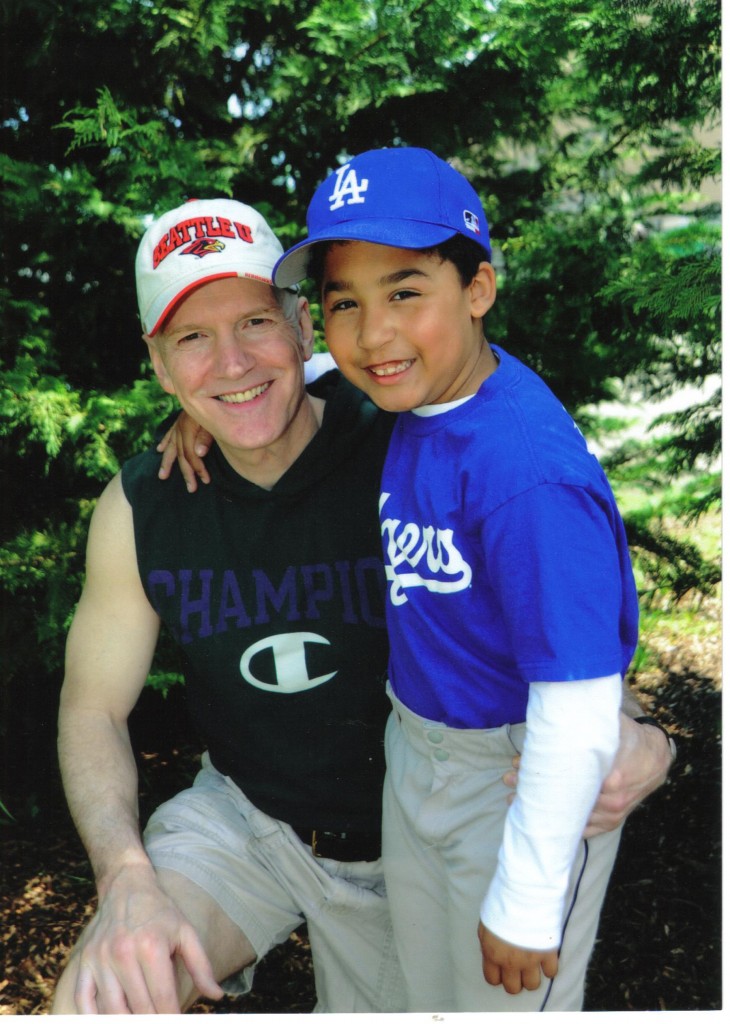Clay Moyle and son Caleb
Whenever the subject of the greatest pound-for-pound fighter of all time is raised, what the majority of folks think of is Sugar Ray Robinson. Robinson is certainly a worthy candidate for the title. After compiling an amateur record of 85-0 he turned professional in 1940 and by 1951 had compiled a record of 128-1-2, including an unbeaten streak of 91 contests.
Robinson held the world welterweight title from 1946 to 1951 and ultimately won the world middleweight title a remarkable four times before his career ended in 1965 with an overall professional record of 173 wins, 19 losses and 6 draws.
But, there’s another man, along with my own favorite Sam Langford, whom I believe is more worthy of that title and his name is Harry Greb.
I just finished reading a monstrous 641-page biography concerning the life and career of Greb by Steve Compton titled Live Fast, Die Young: The Life and Times of Harry Greb. The finished product was the culmination of more than 11 years of work by the author.
Compton was originally a big fan of the early 20th century world heavyweight champion and legend Jack Dempsey. But, in much the same way that I became fascinated with Sam Langford as I researched that era in boxing history myself, Compton quickly become obsessed with Harry Greb as he began to learn more about that great fighter’s ring exploits.
His obsession grew, especially, when it became apparent to him that Dempsey appeared to duck him after winning the heavyweight crown. Dempsey, who was voted the greatest fighter of the first half of the twentieth century by a poll of 300 Associated Press sportswriters, gained the heavyweight title by virtue of knocking out the gigantic six-foot-six, 260-pound Jess Willard on July 4, 1919.
When it came time for Dempsey and his manager, Jack Kearns, to select their first opponent to defend the title against they settled on Billy Miske. Miske had already given Dempsey a couple of very tough battles including one contest ruled a draw. But, when the pair met on September 6, 1920 in Benton Harbor, Michigan, Miske was suffering from what would ultimately prove to be a fatal kidney disease and presented no challenge to Dempsey, who knocked him out early in the contest.
While training for the bout with Miske, Dempsey engaged in some spirited sparring sessions with Greb. To the great surprise of those who witnessed the action, Greb gave the champion all he could handle despite a disadvantage of several inches in height and 25-pounds in weight.
According to one reporter, “Greb was all over him and kept forcing him around the ring throughout the session. Dempsey could do little with the speedy Greb, while Greb seemed to be able to hit Dempsey almost at will. Time and again, Greb made the champion miss with his famous right and left hooks to the head and countered with heavy swings to the head and hooks to the body.”
Sadly, Greb never received an opportunity to fight the champion. Dempsey and his manager kept telling the press and anyone else who would listen that Harry was too small to face Dempsey for the title.
But, if you examine the list of six men that Dempsey defended against while he wore the heavyweight crown you will discover that Greb not only fought four of those men but defeated each of them as well.
After knocking out Billy Miske, Dempsey and his manager selected “K.O.” Bill Brennan as their next opponent and Dempsey knocked the challenger out on December 14, 1920.
Greb, the man that Dempsey and his manager maintained was too small to face the champion, had defeated Brennan three times in 1919!
In the summer of 1923, Dempsey selected Tommy Gibbons as his next opponent after a two-year layoff. Greb was left out in the cold despite the fact he’d defeated Gibbons the last two times the pair had faced one another, most recently in March of 1922.
Gene Tunney, the man who would ultimately remove the crown from Dempsey’s head, officially lost only one bout during his outstanding professional career. Any guess who he suffered that defeat against?
That’s right it was none other than Harry Greb. Harry dominated Tunney over 15 rounds the first time the pair met on May 23, 1922. They went on to face one another five times over a three-year period, and while the record book indicates Tunney came out on top in four of the contests, there are many who witnessed those fights that maintain Greb deserved the decision in at least three of them.
What is truly amazing is the fact that Greb fought all five of those matches against Tunney with only one eye. Again, like Sam Langford, Greb permanently suffered the loss of vision in one eye as a result of one of his fights. In Greb’s case, it occurred during a bout against “Kid” Norfolk on August 29, 1921.
Remarkably, Greb would go on to enter the ring 89 more times despite the handicap and defeat the likes of not only Tunney but Tommy Gibbons, Tommy Loughran, Johnny Wilson, and “Tiger” Flowers among many, many others.
Greb fought so often during some years he could darn near keep in shape from those fights alone. For example, he engaged in a total of 37 contests in 1917 alone, some of those as few as two days apart!
Nowadays, some fighters don’t fight that many times in their career.
Greb entered the ring a total of 301 times over the course of a 13 and half-years professional career that saw him win 264 times against only 24 losses and 13 draws.
Unfortunately, there is no known film existing of this great fighter in action. A number of his fights were filmed, including a famous meeting against Mickey Walker, but to the best of knowledge there is no surviving film.
In fact, the search for a film of Greb in action has become the Holy Grail among fanatical fight film collectors, who pray that one will one day surface.
In the meantime, we’re left with only the many colorful accounts of an amazing little fighter who many boxing historians believe may have been greater than even Sugar Ray Robinson.
One can only imagine what Greb’s style must have looked like when you read of how he overwhelmed opponents with a dizzying volume of punches thrown from an unbelievable number of angles. More than one witness compared his movements to that of a kangaroo as they watched him bound around the ring, leaping in and out, from side to side, and up and down while making his opponent look foolish and piling up points as he sliced them to ribbons.
If you’re at all curious to learn more about this largely forgotten boxing legend, I would encourage you to purchase a copy of the book. I know it’s available on Amazon.com.
The book is illustrated throughout with hundreds of rare photographs of Greb and his contemporaries and I guarantee there will never be a more thorough and accurate account of the man’s ring career.




